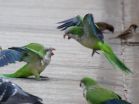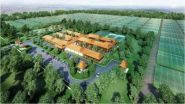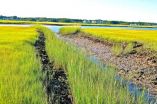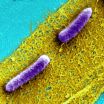(Press-News.org) VIDEO:
In this Science Minute from NIMBioS, Dr. Elizabeth Hobson explains what monk parakeets can teach us about complex sociality.
Click here for more information.
KNOXVILLE—Science has learned a great deal about complex social behavior by studying nonhuman mammals and primates, but parrots might have something to teach too.
With their unusually large brains relative to their body size and advanced cognition, parrots live in a complex social environment---not merely in a large population of cooperating creatures, such as bees or ants, but in a dynamic setting of alliances and competitors. The same is true of the most intelligent mammals: dolphins, whales, primates, and social carnivores, like hyenas and lions.
A new study -- the first to quantify the social lives of parrots using social network analysis – provides intriguing new insights into parrot sociality revealing a sophisticated social structure with layers of relationships and complex interactions.
In the study, researchers observed both wild monk parakeets in Argentina and captive ones in Florida to test several common but largely untested assumptions about parrot sociality.
Because parrots are often observed flying in pairs in the wild, one assumption is that parrot sociality revolves around the pair bond. But are the parrots flying with a true mate or simply flying with any individual?
Coupling the extensive field study with in-depth network analyses revealed that parrots – at least those in captive groups – do show a strong preference for associating with a specific individual and are usually found nearby their mate. In addition, the social networks of captive groups were highly connected with very strong associations with one or two other individuals, multiple moderate associates, and only a few weak associates.
The new research demonstrates that the pair is indeed the fundamental unit of monk parakeet social structure, but additional tiers of social structure, akin to social levels documented in elephants, sea lions, and dolphins, may also be present.
In addition to these positive social relationships, captive monk parakeet groups were also structured by aggression. Researchers used observations of winners and losers in aggressive encounters to assign individual parakeets a dominance rank.
Together, the new research shows that the social lives of monk parakeets are structured by several types of relationships. In order for individuals to recognize where they fit in to the social structure of their group, they would need to recognize and remember others in their group, to remember how they interacted with specific individuals, and to remember the outcomes of those interactions. Managing this process may require significant cognitive skills.
"Understanding the social systems of parrots is critical to understanding social processes, such as vocal learning and the spread of behaviors, and can also give us greater insight into how social and cognitive complexity evolved in other species," explained lead author Elizabeth Hobson, a postdoctoral fellow at the National Institute for Mathematical and Biological Synthesis.
"Many parrot species are threatened or endangered and increased understanding of how parrots structure their social interactions could also improve our ability to manage these populations," Hobson added.
INFORMATION:
The study was published in The Auk: Ornithological Advances.
Citation: Hobson EA, Avery M, Wright TF. September 2014. The socioecology of Monk Parakeets: Insights into parrot social complexity. The Auk: Ornithological Advances.
The National Institute for Mathematical and Biological Synthesis is an NSF-supported center that brings together researchers from around the world to collaborate across disciplinary boundaries to investigate solutions to basic and applied problems in the life sciences.
To learn more, visit http://www.nimbios.org.
Being social: Learning from the behavior of birds
New study elucidates the social world of parrots
2014-09-17
ELSE PRESS RELEASES FROM THIS DATE:
Malaysia's 'Smart Villages' and 9 other proven ideas for sustainable development
2014-09-17
As nations zero in on the UN's post-2015 global Sustainable Development Goals, innovations being successfully pioneered and demonstrated in Malaysia offer several proven tactical ideas for improving the world, says an influential international sustainable development networking organization.
The UN's Sustainable Development Solutions Network (SDSN), through its Malaysian chapter, cites ways in which the country is "rising to the challenge," including the construction of ingenious, self-sustaining "smart" villages -- each lifting about 100 families out of poverty and ...
New study examines the impact of socioeconomic position and maternal morbidity in Australia
2014-09-17
The risk of severe maternal morbidity amongst women in Australia is increased by lower socioeconomic position, suggests a new study published today (17 September) in BJOG: An International Journal of Obstetrics and Gynaecology.
Australians generally enjoy high standards of living; however, existing research has concluded that health disparities exist, in particular between indigenous and non indigenous Australians.
This case-control study aimed to explore the independent impact of socioeconomic position on severe maternal morbidities associated with direct maternal ...
Global change: Trees continue to grow at a faster rate
2014-09-17
Trees have been growing significantly faster since the 1960s. The typical development phases of trees and stands have barely changed, but they have accelerated -- by as much as 70 percent. This was the outcome of a study carried out by scientists from Technische Universität München based on long-term data from experimental forest plots that have been continuously observed since 1870. Their findings were published recently in Nature Communications.
Three decades ago, "forest dieback" was a hot topic, with the very survival of large forest ecosystems seemingly in doubt. ...
Nanoscience makes your wine better
2014-09-17
One sip of a perfectly poured glass of wine leads to an explosion of flavours in your mouth. Researchers at Aarhus University, Denmark, have now developed a nanosensor that can mimic what happens in your mouth when you drink wine. The sensor measures how you experience the sensation of dryness in the wine.
When wine growers turn their grapes into wine, they need to control a number of processes to bring out the desired flavour in the product that ends up in the wine bottle. An important part of the taste is known in wine terminology as astringency, and it is characteristic ...
The mobility model is closely linked to the city's characteristics
2014-09-17
This news release is available in Spanish and Spanish.
As far as the conclusions of the study are concerned, the following aspects, among others, are worth highlighting: the more compact the town or city is, the more concentrated is its population; the more jobs there are in the municipality itself, etc., the less private vehicles are used; the better the offer of public transport, the lower the number of people who use private cars; the higher the per capita income is (in small localities), the greater is the tendency to use the private car. According to Mendiola, ...
Magnetic resonance helps to detect and quantify fat in liver
2014-09-17
This news release is available in Spanish.
Obesity and overweight affect more than half of the population in our Community. Excess weight causes important alterations in the organism, one of which affects liver function. Fat accumulates in the liver producing hepatic steatosis which, in certain circumstances, causes inflammation, fibrosis and finally, cirrhosis. To date, the most reliable method for determining hepatic fat has been hepatic biopsy. Imaging techniques such as abdominal ecography detect it but are less precise for determining the quantity of fat.
But ...
Car hacking: The security threat facing our vehicles
2014-09-17
The car of the future will be safer, smarter and offer greater high-tech gadgets, but be warned without improved security the risk of car hacking is real, according to a QUT road safety expert.
Professor Andry Rakotonirainy will speak at the Occupational Safety in Transport Conference (OSIT) on the Gold Coast on September 18-19 on the security threat facing drivers as vehicles become computers on wheels.
Professor Rakotonirainy, from QUT's Centre for Accident Research & Road Safety - Queensland (CARRS), has researched the security systems of existing fleet, future ...
Survey finds benefits, risks of yoga for bipolar disorder
2014-09-17
PROVIDENCE, R.I. [Brown University] — Right now no one can say whether yoga provides clinical benefits to people with bipolar disorder, but in a new article in the Journal of Psychiatric Practice, researchers report survey responses they gathered from scores of people with the condition who practice yoga. What the collective testimony suggests is that yoga can be a substantial help, but it sometimes carries risks, too.
"There is no scientific literature on hatha yoga for bipolar disorder," said lead author Lisa Uebelacker, associate professor (research) of psychiatry ...
Cape Cod saltmarsh recovery looks good, falls short
2014-09-17
PROVIDENCE, R.I. [Brown University] — After decades of decline, grasses have returned to some once-denuded patches of Cape Cod's saltmarshes. To the eye, the marsh in those places seems healthy again, but a new study makes clear that a key service of the marsh – coastal protection – remains diminished.
"We've got the aesthetics back but the ecosystem function hasn't come back," said ecologist Mark Bertness, professor of biology at Brown and senior author of the study in the journal Biological Conservation. "The metric of a recovered habitat should not be 'Does it look ...
Recruiting bacteria to be technology innovation partners
2014-09-17
For most people biofilms conjure up images of slippery stones in a streambed and dirty drains. While there are plenty of "bad" biofilms around – they even cause pesky dental plaque and a host of other more serious medical problems – a team at the Wyss Institute for Biologically Inspired Engineering at Harvard University sees biofilms as a robust new platform for designer nanomaterials that could clean up polluted rivers, manufacture pharmaceutical products, fabricate new textiles, and more.
In short, they want to give biofilms a facelift, and have developed a novel protein ...
LAST 30 PRESS RELEASES:
New modeling approach sheds light on rare gut disease
Study documents potentially hazardous flame retardants in firefighter gear
Can certain bacteria regulate aging of the immune system and its related alterations?
AI model helps diagnose often undetected heart disease from simple EKG
There are fewer online trolls than people think
Cell membrane fluctuations produce electricity
Jeonbuk National University study shows positive parenting can protect adolescents against self-harm
Surface-engineered ZnO nanocrystals to tackle perfluoroalkyl substance contamination
This new understanding of T cell receptors may improve cancer immunotherapies
A new fossil face sheds light on early migrations of ancient human ancestor
A new immunotherapy approach could work for many types of cancer
A new way to diagnose deadly lung infections and save lives
40 percent of MRI signals do not correspond to actual brain activity
How brain-inspired algorithms could drive down AI energy costs
Gum disease may be linked to plaque buildup in arteries, higher risk of major CVD events
Contrails are a major driver of aviation’s climate impact
Structure of dopamine-releasing neurons relates to the type of circuits they form for smell-processing
Reducing social isolation protects the brain in later life
Keeping the heart healthy increases longevity even after cancer
Young adults commonly mix cannabis with nicotine and tobacco
Comprehensive review illuminates tau protein's dual nature in brain health, disease, and emerging psychiatric connections
Book prepares K-12 leaders for the next public health crisis
Storms in the Southern Ocean mitigates global warming
Seals on the move: Research reveals key data for offshore development and international ecology
Sports injuries sustained during your period might be more severe
World's first successful 2 Tbit/s free-space optical communication using small optical terminals mountable on satellites and HAPS
Can intimate relationships affect your heart? New study says ‘yes’
Scalable and healable gradient textiles for multi‑scenario radiative cooling via bicomponent blow spinning
Research shows informed traders never let a good climate crisis go to waste
Intelligent XGBoost framework enhances asphalt pavement skid resistance assessment
[Press-News.org] Being social: Learning from the behavior of birdsNew study elucidates the social world of parrots









